- Regulatory Status
- RUO
- Other Names
- Soluble IL-2R, soluble T cell growth factor receptor (TCGFR), soluble TAC antigen (p55), soluble IL-2R alpha, soluble CD25
- Ave. Rating
- Submit a Review
- Product Citations
- publications
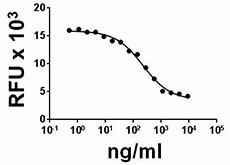
-

Inhibition of M07e cells proliferation induced by IL-2 in the presence of mouse IL-2Rα.
| Cat # | Size | Price | Quantity Check Availability | Save | ||
|---|---|---|---|---|---|---|
| 550006 | 100 µg | £433 | ||||
IL-2 was initially identified as a T cell growth factor and plays a key role in the development and homeostasis of Tregs. The IL-2 receptor is a trimeric complex constituted by three different subunits: α (CD25), β (CD122), and common γ (CD132) chains expressed on the surface of activated T cells. Upon activation, immune cells proliferate and CD25 is cleaved from the surface by MMP-2 and MMP-9. Soluble IL-2Rα (sIL-2Rα) binds to IL-2 in vitro, but with a low affinity (kD = 0.03 mol/l) compared with IL-2Rαβγ complex binding of IL-2 (kD = 10−11 mol/l). sIL-2Rα acts as an inhibitor of IL-2 induced T cell responses in vitro. Also, sIL-2Rα enhances Th17 responses in vitro and acts early during Th17 development by inhibiting signaling downstream of IL-2R through its ability to sequester local IL-2. sIL-2Rα exacerbates experimental autoimmune encephalomyelitis and enhances generation of Th17 type responses in the periphery and increases infiltration of CD4+ Th1 and Th17 cell subsets into the central nervous system. sIL-2Rα is considered a clinically valuable tool for several diseases. High serum levels of sIL-2Rα have been observed in sarcoidosis and autoimmune diseases like systemic lupus erythematosus and rheumatoid arthritis. Also, sIL-2Rα is elevated in neoplastic disorders. It appears useful in stimulating survival and monitoring therapy of malignant melanoma or nasopharyngeal carcinoma.
Product DetailsProduct Details
- Source
- Mouse IL-2Rα, amino acids (Glu22-Lys236) (Accession# NM_008367), was expressed in CHO cells. 10His-tag in the carboxy terminus.
- Molecular Mass
- The 230 amino acid recombinant protein has a predicted molecular mass of approximately 26.4 kD. The DTT-reduced and non-reduced glycosylated protein migrate at approximately 50 - 58 kD and 40 -55 kD respectively by SDS-PAGE. The predicted N-terminal amino acid is Glu.
- Purity
- >95%, as determined by Coomassie stained SDS-PAGE.
- Formulation
- 0.22 µm filtered protein solution is in PBS.
- Endotoxin Level
- Less than 0.01 ng per µg cytokine as determined by the LAL method.
- Concentration
- 25 µg size is bottled at 200 µg/mL. 100 µg size and larger sizes are lot-specific and bottled at the concentration indicated on the vial. To obtain lot-specific concentration and expiration, please enter the lot number in our Certificate of Analysis online tool.
- Storage & Handling
- Unopened vial can be stored between 2°C and 8°C for up to 2 weeks, at -20°C for up to six months, or at -70°C or colder until the expiration date. For maximum results, quick spin vial prior to opening. The protein can be aliquoted and stored at -20°C or colder. Stock solutions can also be prepared at 50 - 100 µg/mL in appropriate sterile buffer, carrier protein such as 0.2 - 1% BSA or HSA can be added when preparing the stock solution. Aliquots can be stored between 2°C and 8°C for up to one week and stored at -20°C or colder for up to 3 months. Avoid repeated freeze/thaw cycles.
- Activity
- ED50 is 0.2 - 0.6 µg/ml, corresponding to a specific activity of 1.6 - 5.0 x 103 units/mg, as determined by inhibition of M07e cell proliferation induced by human IL-2.
- Application
-
Bioassay
- Application Notes
-
This product is reactive with mouse and human.
BioLegend carrier-free recombinant proteins provided in liquid format are shipped on blue-ice. Our comparison testing data indicates that when handled and stored as recommended, the liquid format has equal or better stability and shelf-life compared to commercially available lyophilized proteins after reconstitution. Our liquid proteins are verified in-house to maintain activity after shipping on blue ice and are backed by our 100% satisfaction guarantee. If you have any concerns, contact us at tech@biolegend.com.
Antigen Details
- Structure
- Receptor
- Distribution
-
Activated T lymphocytes, regulatory T cells, NK cells, monocytes, B cells.
- Function
- sIL-2R acts as an inhibitor of IL-2 induced T cell responses in vitro and enhances Th17 responses in vitro. sIL-2R production is induced upon lymphocyte activation, and it is induced by LPS and IFN-gamma; in monocytes.
- Bioactivity
- Inhibition of M07e cell proliferation.
- Cell Type
- Tregs
- Biology Area
- Immunology, Stem Cells
- Molecular Family
- CD Molecules, Cytokine/Chemokine Receptors, Soluble Receptors
- Antigen References
-
1. Brusko TM, et al. 2009. PLos One 4:e7980.
2. Maier LM, et al. 2009. J. Immunol. 182:1541
3. RusselSE, et al. 2012. PLoS One 7:e47748.
4. Wei L, et al. 2013. Immunity 38:13.
5. Downes K, et al. 2014. Diabetologia 57:366. - Gene ID
- 16184 View all products for this Gene ID
- UniProt
- View information about IL-2Ralpha on UniProt.org
Related FAQs
- Why choose BioLegend recombinant proteins?
-
• Each lot of product is quality-tested for bioactivity as indicated on the data sheet.
• Greater than 95% Purity or higher, tested on every lot of product.
• 100% Satisfaction Guarantee for quality performance, stability, and consistency.
• Ready-to-use liquid format saves time and reduces challenges associated with reconstitution.
• Bulk and customization available. Contact us.
• Learn more about our Recombinant Proteins. - How does the activity of your recombinant proteins compare to competitors?
-
We quality control each and every lot of recombinant protein. Not only do we check its bioactivity, but we also compare it against other commercially available recombinant proteins. We make sure each recombinant protein’s activity is at least as good as or better than the competition’s. In order to provide you with the best possible product, we ensure that our testing process is rigorous and thorough. If you’re curious and eager to make the switch to BioLegend recombinants, contact your sales representative today!
- What is the specific activity or ED50 of my recombinant protein?
-
The specific activity range of the protein is indicated on the product datasheets. Because the exact activity values on a per unit basis can largely fluctuate depending on a number of factors, including the nature of the assay, cell density, age of cells/passage number, culture media used, and end user technique, the specific activity is best defined as a range and we guarantee the specific activity of all our lots will be within the range indicated on the datasheet. Please note this only applies to recombinants labeled for use in bioassays. ELISA standard recombinant proteins are not recommended for bioassay usage as they are not tested for these applications.
- Have your recombinants been tested for stability?
-
Our testing shows that the recombinant proteins are able to withstand room temperature for a week without losing activity. In addition the recombinant proteins were also found to withstand four cycles of freeze and thaw without losing activity.
- Does specific activity of a recombinant protein vary between lots?
-
Specific activity will vary for each lot and for the type of experiment that is done to validate it, but all passed lots will have activity within the established ED50 range for the product and we guarantee that our products will have lot-to-lot consistency. Please conduct an experiment-specific validation to find the optimal ED50 for your system.
- How do you convert activity as an ED50 in ng/ml to a specific activity in Units/mg?
-
Use formula Specific activity (Units/mg) = 10^6/ ED50 (ng/mL)
 Login / Register
Login / Register 







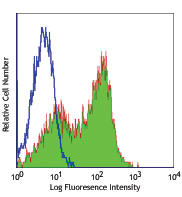
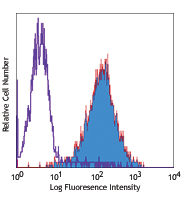
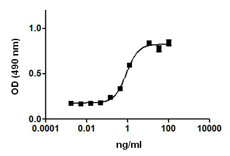
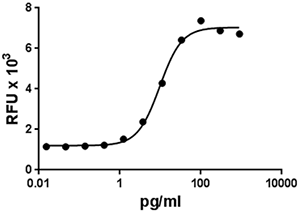



Follow Us